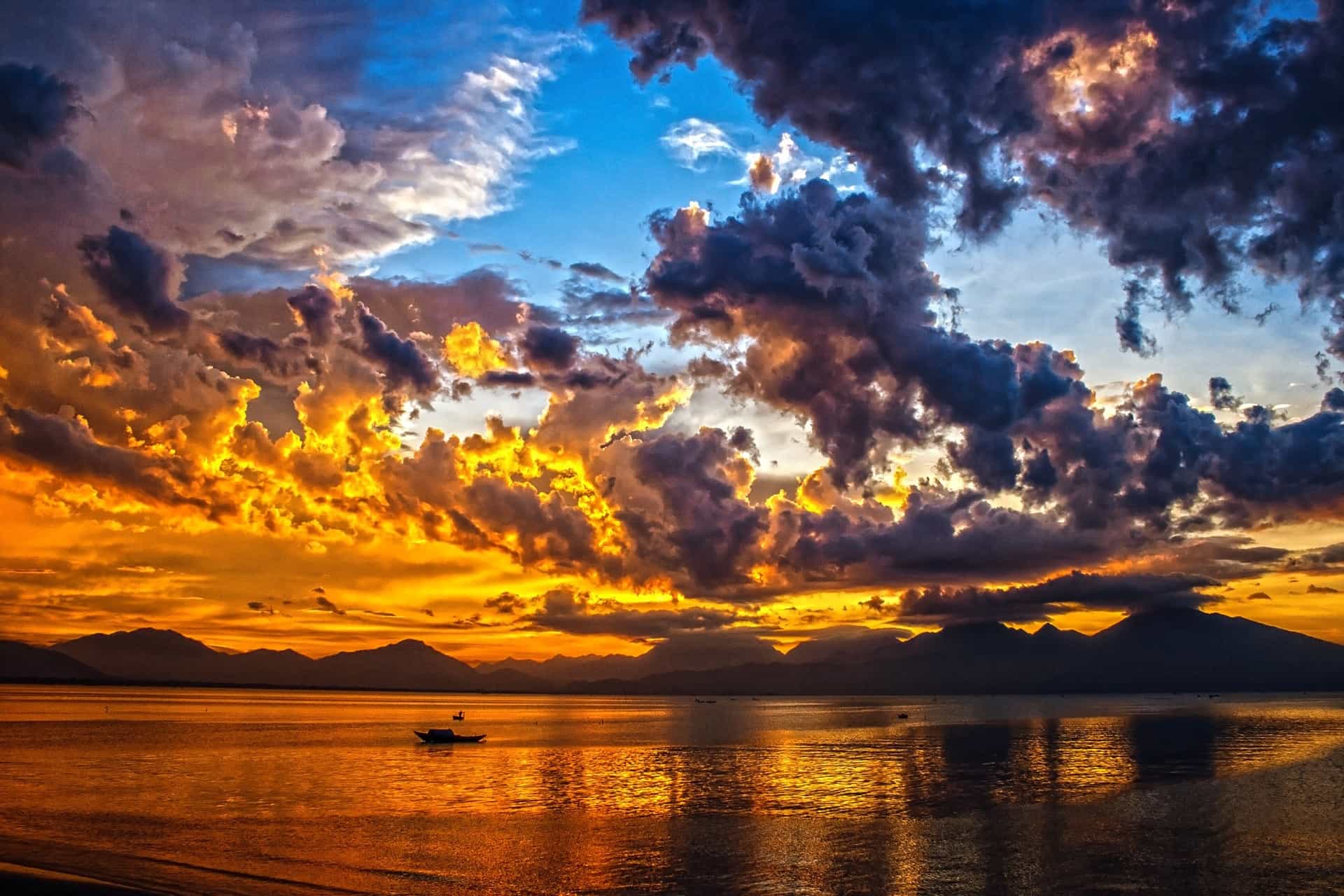Contents
The 8 regions of Vietnam – and important places to visit in each.
Tourists usually flock to Hanoi, the capital city, and so it is no wonder that it is consistently ranked among the world’s famous destinations. However, a lot of tourist also explore beyond Hanoi, goins as far as HaGiang, a lovely province in the northeast region known for its steep hills, karst plateau, and winding roads. Tourists who frequent Ha Gian are mostly Europeans.
Found in Southeast Asia, Vietnam is a long, thin country connected to China, Laos, and Cambodia. The country is divided into eight regions: Northwest, Northeast, Red River Delta, North Central Coast, South Central Coast, Central Highlands, Southeast, and Mekong River Delta.
Here, we will give you a guide to each of the region, and the places to visit in each.
1. NORTHERN VIETNAM (Tây Bắc)
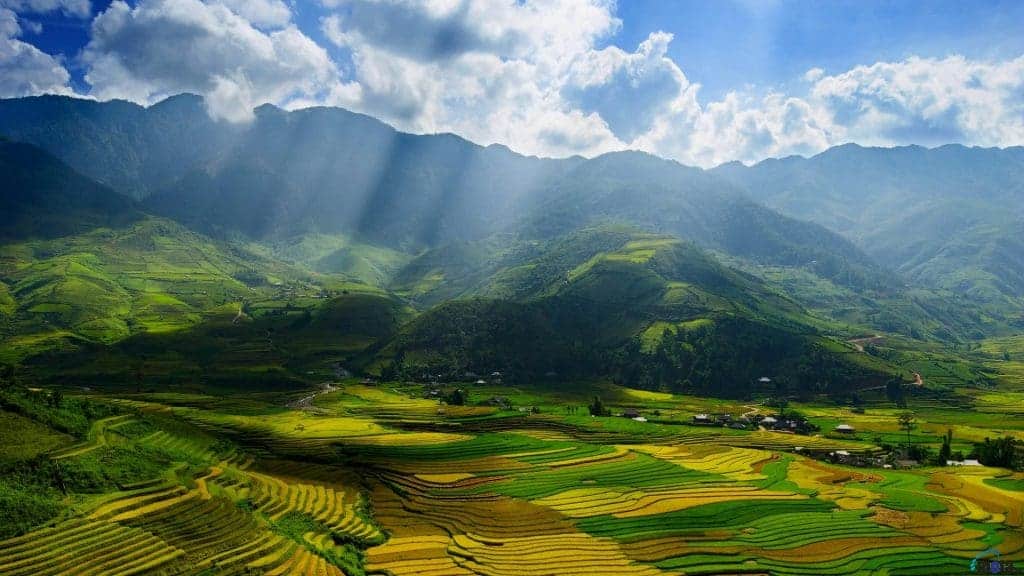
Northern Vietnam boasts of the most spectacular scenery in the whole of Vietnam. It is the place to visit if you want to experience cultural and natural wonders, considering this region is mostly the origin of Vietnam’s culture and history.
Northern Vietnam’s landscape is astonishing: stunning views of near-vertical rice terraces and glorious mountains. Actually, it is in Northern Vietnam where the Hoang Lien Mountains, or the TolkineseAps, are found, imposing and breathtaking, and rising to meet the sky.
The Hoang Lien Son mountain range is an extension of the Himalayas. At the feet of the mountains lie a variety of ethnic minorities, a mix of colorful hill tribes, such as Tay, Dzao, and H’Mong.
The Hoang Lien Son’s Fansipan is the highest peak among the range, 3, 143, high above the sea level, running from North West to South West, right in the center of Lao Cai province and Lai Chau province, even reaching far into the Yen Bai province in the West.
Fansipan, Lung Cung, and Pu Long are the three highest peaks in Northwest Vietnam.
Some of the important sights in Northwestern Vietnam are:
a. Bac Ha Market
Bac Ha is the largest minority people’s market in Northwest Vietnam. It is held every Sunday, and this is where you will meet the friendly local people from minority groups, such as the Flower Hmong (Red Hmong), Black Dao, Tay, Nung, La Chi, Phu La.
You will also be delighted to see the elaborate and vibrant costume of the Flower Hmong. The women of the Flower Hmong wear multiple layers of bright clothing, which include a detailed and ornamented shawl fastened to the neck with a collar, plus another layer similar to an apron. The materials of their exotic attire are made of tightly woven strips of multicoloured fabric, with a frilly edge. Head gear, opulent cuffs and ankle fabrics also comprise their attire.
The normally sleepy and quiet town of Bac Ha comes alive on Sunday mornings, with the area brimming with wares and goods and livestock, and crowded with hill tribes and valley folks and tourists. You can get yourself handicrafts and souvenirs.
It is rather a cinematic sight during Bac Ha Market Day—image a busy market against a backdrop of lush mountains, sloping rice paddies, and rolling, verdant valleys. It is a very unique experience.
If you wish to see Bac Ha in its full glory, the best way to be there is very early, right before tourist buses hit the market, which is around 10 or 11 in the morning. If you wish to see the market in full swing, it is advisable that you depart Sapa as early as 5am, or arrive the day before and spend the night in Bac Ha.
b. Dien Bien Phu Museum
The futuristic gray building contains a diverse collection of the great 1954 battle of Dien Bien Phu.
The exhibits in the museum, which was established in 1984, are split into 5 sections: Dien Bien Phu’s vital position, the enemy garrison at Dien Bien Phu, the Communist Party leadership of Vietnam in the Dien Bien Phu campaign, the result and aftermath of the Dien Bien Phu victory, and Dien Bien Phu as it is today.
Expect to see usual museum features, like old photos, documents, French and US military objects from the battle, weaponry, artillery guns, tanks, canons, machine guns, plus an interesting bath tub that once belonged to French Commander Colonel de Castries. There is also a huge diorama of the battlefield.
There is a total of 270 objects in the museum, plus 200 photographs and paintings.
c. Sapa Museum
A must-see! It is an outstanding exhibit of Sapa’s history and ethnology, as well as the French colonization. If you are a history buff, you will be delighted by the showcase, including the distinct differences between ethnic minority people of Sapa.
The entire tour will only take about 30 minutes. Even if you are no history nut, you will enjoy the visit, guaranteed.
Sapa Museum is actually housed in a lovely, traditional stilt house. In the upstairs area, you will learn about the history of Sapa, as well as exhibits of ethnic minorities and their rich culture.
The downstairs will take you to a sponsored exhibit of Hmong and Red Dao peoples’ crafts and customs. There is an organization called the Sapa Fair Crafts, with the objective to promote traditional crafts and open economic opportunities. Therefore, the exhibit focuses on these peoples’ handicrafts.
Actually, Sapa Museum will remind you of the Ethnology Museum or Women’s Museum in the capital city of Hanoi—except this one is smaller.
d. Dong Van Market
Every Sunday, local villagers from nearby hills—within a 25-km radius of the town— trek down to Dong Van, the second farthest town in the north, for the market. And Dong Van becomes a festive, colorful, bustling morning.
Local villagers who trade in Dong Van include the Hoa, Tay, Nung, and White Hmong, Black Dao ethnic minorities. It is popular for its cultural diversity, and the showcase of dazzling and exotic Hmong attires world by the young and old. It’s like a fashion runway show—so mesmerizing and happiness-inducing.
As early as 7 in the morning, Dong Van comes alive. The fragrance of rice wine floating in the air; a semi-chaotic vision of cats, dogs, birds, buffalos, pigs, and ducks handed over and purchased. Singing birds, technicolor rugs, scarves, handmade incense, Hmong shirts, skirts, and more.
After 7am, it is a manic house—crowded but utterly beautiful. An authentic and unforgettable cultural experience.
e. A1 Hill
This is the most famous site of the Dien Bien Phu battle between the French and the Vietnamese in 1954. It was also recorded in history as one of the most savage battles in between the French and Vietnamese armies.
The hilltop is now an open-air museum, where you can view traces of the battle, including one of two tanks that the French used to make their cons-offensive. And right next to the tank is the tomb of four soldiers who joined in the attacks.
In the site is also a monument to Viet Minh, and the complex trenches at the center of the French defences have also been recreated in A1 Hill.
f. Can Cau Market
Held every Saturday at 7:30 in the morning near the Chinese border, in Si Ma Cai District, the Can Cau Market is a rich cultural experience. It is an explosion of vibrant colors and high-energy crowd. Also, there is an impressive selection of goods traded in this market—from clothing, to fabric, to livestock, corn wine, and more. The market extends down to the hillside, with stalls categorized—one level is lined with food stalls, and at the bottom of the valley, stalls of livestock, including canines.
You will be delighted to meet ethnic minorities in Can Cau Market, such as the Flower Hmong (Red Hmong), Blue Hmong,Nung, Phu La and even Chinese people from across the border.
Some tourists will proceed to Bac Ha Market the next day, which is 20km away from Can Cau Market. And some tourists go for an afternoon trek to the nearby Fu La Village, after visiting the market.
g. Muong Cultrual Museum
The Muong Cultural Museum is founded by Hanoi Artist Vu DucHieu in 2007, and is nestled on a hill at the heart of a limestone valley, stretching 5 hectares. It was once the home of ancient Muong People.
This museum displays the culture of the local Muong ethnic minority. It is the first private historical museum of the Muong people, with the exhibit housed in four complexes of stilt houses.
h. Tram Ton Pass
Found on the northern side of Fansipan and 15 kilometers from Sapa is the Tram Ton Pass, where the road between Sapa and Lai Chau crosses over.
Tram Ton Pass is Vietnam’s highest mountain pass, rising 1900 meters and magically acts as a border between two weather fronts—on the Sapa side, it is cold and misty and drizzling sometimes, and on the other side, on the Lai Chau side, it is summer; all warm and sunny.
Tram Ton Pass is often called “Heaven’s Gate” for its glorious, awe-inspiring landscapes, sweeping vistas—the beauty so otherworldly that it will stun you.
You may trek up the far side of Fansipan and the Hoang Lien Mountain Range. From a specific vantage point, you will be rewarded with an unhampered view of the intensely beautiful Fansipan dotted with verdant forests.
This mountain road begins 9 miles north of Sapa, which also serves as a lookout more than 6,200 feet above sea level. The Tram Ton Pass stretches 75 miles and to cross it by car will take you approximately 3 hours.
Sapa Day Tours usually include the Tram Ton Pass, where you will drive a portion of it to drink in the views, including the famous Silver Waterfall (ThacBac), before enjoying a trek to villages.
If you wish to go through the 75-mile pass on your own, you may rent a scooter or mountain bike; however, be warned of high winds and some road obstructions, like bumps. So in order to safely view the magnificent scenery through Tram Ton Pass, it is more recommended that you do this in a passenger seat in a four-wheeled vehicle.
i. Old French Prison & Museum
It is a former French penal colony once destroyed by American airplane bombers, but partially rebuilt and restored. Turrets have been rebuilt and rise over disintegrating cells. And there is a lone, peach tree still surviving from the 1940s, which was planted by an inmate named To Hieu.
The partial restoration does evoke a deep sense of captivity to visitors.
When visiting the Old French Museum, you will also be given access to the Son La Museum, which is contained in a fusty colonial mansion, which overlooks the Old French Prison.
In the Son La Museum, you will see a showcase of life in Son La in the past, as well as the present day, through a series of photos. This interesting exhibit is in the downstairs area of Son La Museum. In the upstairs section, you will be presented with a recreation of a Thai village, plus a series of display of ethnic minority clothing.
Both the Son La Museum and the Old French Museum are situation on top of a hill at the heart of the town, and can be found next to the People’s Committee Building.
2. NORTHEAST VIETNAM (Đông Bắc)
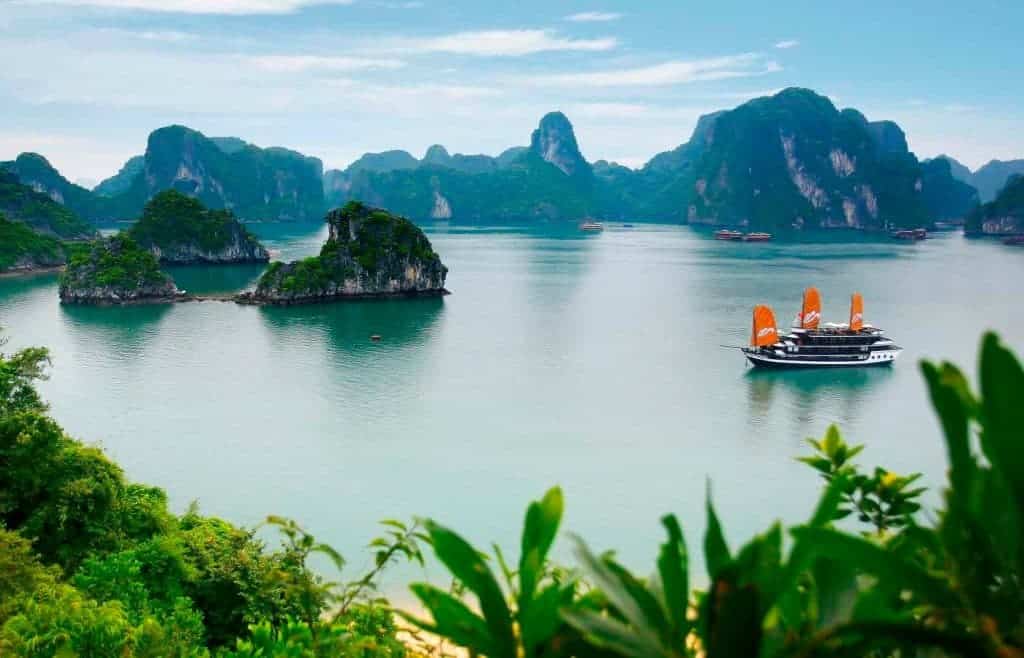
Northeast Vietnam, or Đông Bắc, is synonymous to Ha Long Bay, this magical UNESCO World Heritage Site that is the site of wild beauty: emerald waters, towering limestone islands, brooding and mysterious mountains, and lush rainforests.
Đông Bắc is the region found at the north of the Red River Delta, therefore it is also in the north but only officially titles as “Northeast” to distinguish it from the three sub-regions of Northern Vietnam. It encompasses the provinces northeast of Hanoi.
Ha Long Bay is not the sole asset of Northeast Vietnam. If you venture beyond Ha Long Bay, you will be treated to more spectacular natural wonders: ethereal waterfalls, dramatic mountain passes, fairy tale-like lakes, gorgeous natural parks, and majestic ancient royal citadels.
Also, at the foot of the mountain lies villages of ethnic minority.
Some of the tourist sights in Northeast Vietnam:
a. Lan Ha Bay
Similar to Ha Long Bay in a way it is blessed with over 300 karst islands and limestone outcrops, Lan Ha Bay is another paradise. It also has a collection of white-sand beaches.
Lan Ha is geographically the extension of Ha Long Bay but belongs to a different province in Vietnam. Found in the south of Ha Long Bay, it belongs to Cat Ba Islands, in HaiPhong City. It has a total of 400 islets with small beaches.
Lan Ha Bay has an approximately 139 small beaches, most of them charmingly nestled between two stone mountains.
b. Cat Ba National Park
A designated World Heritage Park and a biosphere reserve in Northern Vietnam, Cat Ba National Park covers approximately 30 kilometers, consisting of 173 kilometers of land, and 90 square kilometres of inshore water.
Cat Ba National Park is famous to hiking enthusiasts because of the park’s spectacular natural features: freshwater national parks, sub-tropical verdant forests, mangroves, coral reefs, Viet Vai villages, and misty, enchanting air quality to it.
There are plenty of activities that you can enjoy in Cat Ba National Park. The park has a zoo, called the Cat Ba Zoo. You can also thrill in a rock climbing activity on the island, or enjoy a relaxing swim in one of the several beaches, kayaking, , floating fish farms, boat-riding and, of course, hiking—like the challenging 18-km hiking trail up to the mountain summit.
Cat Ba National Park is actually Vietnam’s first ever national park to include both marine and terrestrial ecosystems, boasting of various types of habitat and ecosystem. It is where a unique type of tree called “Cay Kim Giao,” used in ancient times to make chopsticks for kings and noblemen, because the timber of which the chopstick was made of would protect them—the wood turns black if it touched anything poisonous.
Cat Ba National Park is home to 32 types of mammal, including the rare golden-headed langur, or famously known as the “Cat Ba Langur”; there are only 64 langurs left in the entire world, and Cat Ba National Park has most of them. Other mammals present in the park are squirrel, deer, civets, macaques. And there are approximately over 70 bird species that have been recorded in Cat Ba Park, like hornbills, cuckoos, and hawks.
On the other hand, there are a documented 745 species of plants in Cat Ba, and it includes 118 timber species and 160 plants known to have medicinal value.
To truly appreciate Cat Ba National Park, it is recommended that you get a guide to help you navigate and make sense of all the wonderful things this park has to offer.
c. Hang Pac Bo Cave
A very important historical site, Hang Pac Bo Cave is located right in the country’s northeastern frontier with China. It is in this cave where Ho Chi Minh, the Vietnamese Communist revolutionary leader who was prime minister and president, lived for seven weeks. He lived within the cave from February until March of 1941, after he came home from 30 years of exile, working on Vietnam’s revolutionary course. This cave is known in the entire country as a revolutionary resistance base. Looking down into the mouth of the cave, you will catch a glimpse of the date “February 8th, 1941” written across—courtesy of Ho Chi Minh himself.
Ho Chi Minh’s makeshift bed still exists with the cave. It is made of a board. It is in this cave where the revolutionary leader, by an open, crackling fire, often met with his assistants Phung Chi Kien, Vo Nguyen Giap, and Pham Van Dong. It is also where he spoke of his famous prediction: the success of the Vietnamese revolution in 4 or 5 years.
Hang Pac Bo is not only historically significant, but the cave is one enchanting beauty. No wonder it is a popular tourist site. Think sparkling aqua rivers, forested limestone forests.
If you are planning to check out this popular northern Vietnam tourist attraction, here’s what to expect:
From Hanoi, you will drive 272km to the mountainous town of Cao Bang, passing through National Highway No. 3. You will have to spend the night in Cao Bang, since the journey to Pac Bo is still far away. Enjoy sleeping under the open sky and feel the relaxing evening mountain breeze.
The next morning, you will travel to the Ha Quang area, passing through Hoa An. Now, this is one magical ride—you will pass through golden rice fields in the midst of lush, dense mountains, long, sparkling winding streams, small, quaint, charming villages with traditional Vietnamese houses on stilts punctuated with clusters of peach trees. You will also pass by the newly built Ho Chi Minh Museum, along with a collection of historical sites: Bo Bam Cave, Pac Bo, Lenin Stream. Coc Bo, Co Rac Ground, Karl Marx Mountain, and Khuoi Nam.
You may walk along the side of Lenin Stream, where Ho Chi Minh fished. The stream is so clear that you can see through it and catch glimpses of pebbles and fish, as well as green watercress. Then further along, there’s a wooden bridge, and upon crossing, you will reach the area where Ho Chi Minh cooked and prepared soup with bamboo shoots and vegetables.
Pac Bo, where the cave Hang Pac Bo is located, is actually a small village in the province of Cao Bang, in northern Vietnam, in the Ha Quang District. It is found 3 kilometers from the Chinese border. It is 350 kilometers north of Hanoi. Make sure you drop by this place if you have more time, as the Hang Pac Bo cave is not just historically important and an amazing glimpse into a significant period in Ho Chi Minh’s life, but it is visually stunning, and will leave a mark in your soul.
d. Ba Be National Park
A nature reserve located in the province of BacKan in the northeast region of Vietnam, Ba Be National Park was established in 1992 to protect the Ba Be Lake, a freshwater lake in the midst of lowland dense evergreen forests and towering limestone mountains. It is about 240 kilometers north of Hanoi, about 14 kilometers west of the town of Cho Ra.
Ba Be is Vietnam’s eighth national park and is also referred to as Ba Be Lakes, because the lakes dominate the park. But you can also enjoy sights of pristine waterfalls within the park, plus a collection of caves and deep valleys. There is a minimal park entrance fee, which you have to pay at a checkpoint on the road into the park, which is about 15km before the park headquarters, just beyond the of Cho Ra, the capital town of the Ba Be District.
The government of Vietnam actually subsidizes the villagers not to cut down the trees, which helps sustain the lush rainforest that is actually the park. It thrives and blooms with over 550 documented plant species, plus wildlife species that go by the hundreds—65 of them are mostly rare mammals. There are 353 butterfly species, 106 fish species, 4 types of turtles. This park is also home to the highly endangered Vietnamese salamander, and even the Burmese python.
If you are a bird-watching enthusiast, you will very much delight in the immense number of bird species in BaBa National Park. There are 233 documented bird species, and this include the stunning crested serpent eagle (a medium-sized bird of prey that is found in forested habitats across tropical Asia), as well as the oriental honey buzzard.
With all the amazing wildlife in Ba Be National Park, it is strictly laid out that hunting is strictly prohibited. Local villagers are allowed to fish, instead.
Ba Be National Park is home to about 13 tribal villages, majority of which belong to the Tay minority—plus a limited number of Hmong and Dzao ethnic minority group.
The best time to visit Ba Be National Park is during the dry season—which is during the winter, or spring. Do not visit during the wet season, as the lake absorbs water from the Nang River.
e. Ha Long Bay
Located in Quang Ninh Province and part of the Van Don District, Ha Long Bay is a UNESCO World Heritage Site, hugely popular among tourists. It has an area of around 1,533 km2, which includes around 2,000 islets, most of them stunning limestone and uninhabited—untouched islands.
Ha Long Bay translates to “descending dragon bay,” based on a Vietnamese legend of its origins: a mountain dragon swooping down to the coast, its massive tail carving out crevasses and valleys. When the great dragon dove into the sea, the land welled up with water, leaving breathtaking karst formations.
Visiting Halong Bay feels like stepping into a “Lord of the Rings” set, with towering limestone amidst emerald waters, a scatter of islets, punctuated with weathered grottoes, that no wonder Ha Long Bay has become the hottest tourist hub.
Although you can visit Ha Long Bay any time of the year, the most recommended time to visit is November: cobalt-blue skies, perfect sunny weather and less crowds.
Weather is great during the peak season, which is in late May and early August, but of course not advisable if you hate the crowds.
It is not particularly pleasant to visit in the months of January to March, as the weather is wet: rainy, foggy (very much affecting visibility), and instead of looking magical and ethereal, Ha Long Bay at this time looks bleak and almost sinister…like being in a horror flick.
Avoid visiting in the months of May, June, July, August, and September: as during this time, there are usually tropical storms, and boats, and as a result, tourist boats make alternative itineraries.
f. Cannon Fort
If you want a selfie with one of the best views of Vietnam, Cannon Fort is where you should go. Perfectly instagrammable, Cannot Fort offers a jaw-dropping panorama of Cat Ba Island: karsts jutting out of the emerald sea with a dramatic contrast of colorful fishing boats dotting the seascape, and rolling hills and jungles.
Cannon Fort is a newly built historic site in the area. To visit the place would be a walk from Cat Ba Town, which is about 10 minutes and very, very steep.
From Cannot Fort’s entrance gate, you have to walk further to the fort, which will take you about 20 minutes.
In Cannon Fort, you will enjoy underground tunnels and sights of well-preserved gun emplacements, which were originally installed by the Japanese in the Second World War. You may also visit the fort’s small museum, or enjoy and relax in the face. Yes, Cannot Fort has its own café! How charming is that
g. Nguom Ngao Cave
Recognized as one of the most stunning cave systems in the entire Vietnam,NguomNgao Cave is found about 4km from Ban Gioc Waterfall. It is also the most famous limestone grotto in the entire northern mountain province of Cao Bang, with jaw-dropping stalactites in various shapes and sizes.
The cave is actually created by an underground river, extending for several kilometres underground.
Nguom Ngao, the local Tay ethnic minority’s language, means “tiger’s cave” in English. This is because of a legend that the cave used to shelter a community of tigers that would sometimes penetrate nearby villages to hunt and devour livestock and men.
But in historical fact, the cave used to shelter villagers in 1979, during Vietnam’s war with China. The cave was discovered by local villagers in 1921, but it wasn’t until 2006 when it officially opened to the public. And it is now officially recognized as a national relic.
When touring NguomNgao Cave, you, along with other visitors, are only allowed to check out one section. A 1-km concrete path has been established, and lighting fixtures have been installed, specifically for tourists.
The main entrance of Nguom Ngao Cave is approximately 2 kilometers from Ban Gioc Waterfalls. From the parking lot to the cave’s entrance is a 10-minute walk—and a very scenic one, too. You will pass by glorious limestone hills, plus fields of soya beans.
The tour inside the cave normally takes an hour, with a guide who speaks in English. The guide will weave you through stalagmites and stalactites, plus through a massive 100-meter chamber.
Just as soon as you step inside the cavern, it is instantly an entirely different world. A fantastical formation of high stone cliffs, multi-colored stalactites with shapes that distinctly vary from one another.
The guided tour will take you into 400 meters into the cave—which only takes an hour.
However, if you want to explore more into the cave, then the guide will take you for another full hour further.
3. RED RIVER DELTA (Đồng Bằng Sông Hồng)
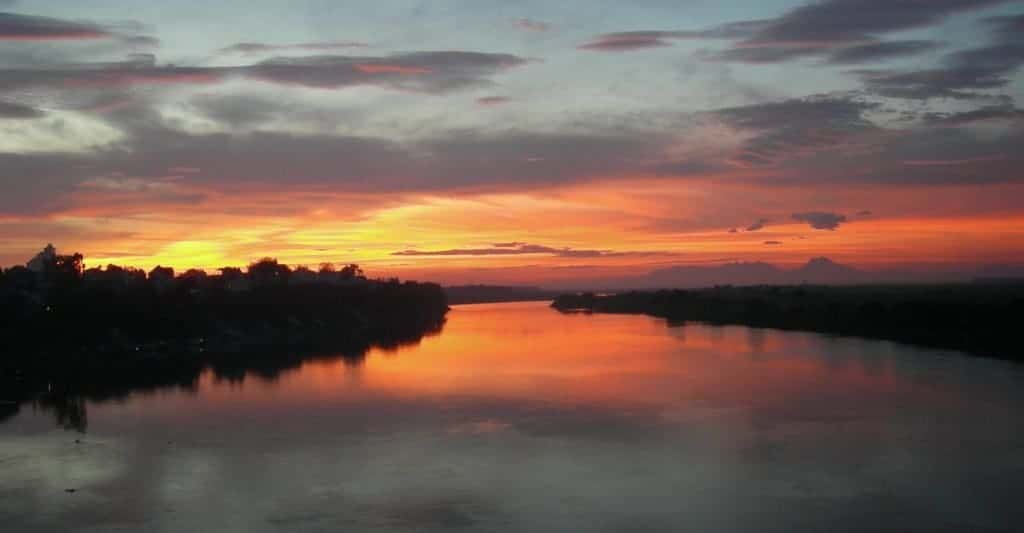
Formed by the Red River, the Red River Delta is a flat low-lying plain, measuring approximately 15,000 sq km. The area’s wealth is its agriculture, with the land mostly dedicated to rice farming.
Red River Delta is also densely populated—with nearly 19 million inhabitants. It comprises of eight provinces, with two municipalities, including Hanoi and the Haiphong Port.
In 2004, the area was officially assigned as the Red River Delta Biosphere Reserve, as part of UNESCO’s Man and Biosphere Programme.
a. Lung Phin Market
Set in the midst of the mountainous area of Ha Giang province, 15 km from MeoVac, Lung Phin Market is a truly amazing place to visit that showcases one of the most typical and colorful hill tribe markets in Vietnam.
Here, you will witness throngs of people from Hmong, Dzao and China flock here every six days on lunar calendar or days of the Monkey and the Tiger where cows, pigs, dogs and local products by blacksmiths, saddlers including traditional medicines, clothing, and food are traded and bartered.
b. Ta Phin Village
Located within a valley below a towering mountain peak is a picturesque village alive with the daily life of the Kinh, Red Dao and Black Hmong people.
The village is dotted with small homes and layered with rice paddies and above these are smaller communities with fields of corn and vegetables.
At Ta Phin Village, you will get to see and experience an authentic Vietnamese village where local people are seen working in the terraced paddy fields, or walking to and from the market. You can also get to buy souvenirs such as cheap Chinese trinkets,handcrafted silver bracelets or fancy Dao dresses. Dried medicinal plants and apple rice wine are also being sold here. Don’t hesitate to haggle. Sometimes they sell up to 3 or 4 times higher than the real price.
c. Imperial Citadel of Thang Long in Hanoi
Added to Unesco’s World Heritage List in 2010, this ancient fortress was once the centerof Vietnamese military and political power for 13 consecutive centuries.
Excavation work at the Thang Long Royal Citadel site revealed numerous aartifacts from the 6th to the 20th century that once belonged to the Ly, Nguyen, Tran, Le eras.
Also found here are foundations of old palaces, ancient roads, ponds and wells and a renovated old stone fortress, popular with visitors. Other discoveries in this site are bronze coins, ceramics and pottery from China and other places in Asia.
d. Ho Chi Minh’s Stilt House
This humble, traditional stilt house was where Ho Chi Minh lived once in a while between 1958 to 1969. Ho Chi Minh was the Communist revolutionary leader of Vietnam who was the prime minister (1945–55) and president (1945–69) of the Democratic Republic of Vietnam (North Vietnam).
The stilt house is set in a well-preserved garden near a fish pond. From here, you can view Hanoi’s Presidential Palace, a beautiful and lavish building constructed in 1906 for the Governor General of Indochina.
The stilt house and the Presidential Palace are part of the Ho Chi Minh Mausoleum Complex along with Ho Chi Minh Museum and the One Pillar Pagoda. Surrounded by botanical gardens, monuments, memorials, and pagodas, this complex is an important place of pilgrimage for many Vietnamese.
e. Perfume Pagoda
Perfume Pagoda (Chùa Hương) is a vast complex of Buddhist temples and shrines built into the limestone mountains of Huong Tich mountains (Mountain of the Fragrant Traces) since the 17th century. To see all the sites in this complex, you would actually need several days. Some of the popular sites here are Den Trinh shrine, the Pagoda Hinh Bong, ThienTru pagoda, the Thanh Son Pagoda, GiaiOan Pagoda, HuongTich cave and the temples Long Van, Cay Khe, and Tuyet Son y Mau Me.
You can start your day with a row-boat trip to visit some of the sights along the ThienTruharbor. From here you can climb to the ancient HuongTich cave on the top of the mountain.
At the mountain, there’s a local restaurant where you can take a leisurely lunch at before heading to the Heaven Kitchen pagoda, a temple built during the Le Dynasty.
4. NORTH CENTRAL COAST (BắcTrungBộ)

North Central Coast or BắcTrungBộ is one of the regions of Vietnam consisting of six provinces: Thanh Hóa, Nghệ An, Hà Tĩnh, Quảng Bình, Quảng Trị, Thừa Thiên–Huế. This region has three out of UNESCO’s seven World Heritage Sites in Vietnam, namely: PhongNha-KẻBàng National Park under Natural, and Complex of Huế Monuments and Citadel of the Hồ Dynasty under Cultural.
a. Phong Nha-Kẻ Bàng National Park
Visit the scenic beauty of the 200 hectare Phong Nha Ke-Bang National Park, a UNESCO World Heritage Site. The site, which shares a boundary with the Hin Namno Nature Reserve in the Peoples Democratic Republic of Laos, is a spectacular jungle scenery with fascinating limestone formations.
In this site you can explore PhongNha Cave by boat, take a peek of Paradise Cave among numerous cave systems that dot the park, or swim in the clear blue rivers beneath luscious foliage.
While enjoying the well-preserved natural wonders, you can get to spot varied wild life –such as the rare Black Langur monkeys.
b. The Complex of Hue Monuments
The Complex of Hue Monuments is located in the city of Hue in central Vietnam. Hue, which isa UNESCO World Heritage Site, was established as the capital of Viet Nam in 1802by Gia Long, the first king of the Nguyen Dynasty.
Hue was the political, cultural and religious center during the Nguyen dynasty until 1945. The Perfume River that cuts through the Capital City, the Imperial City, the Forbidden Purple City and the Inner City, gives the complex great natural beauty.
In this massive complex you can view hundreds of monuments and ruins, such as the Forbidden Purple City, the historic Imperial City, royal tombs, pagodas, temples, flag tower, a library and a museum.
c. Citadel of the Hồ Dynasty
Designated a World Heritage site in 2011, the citadel of the Ho Dynasty is considered as on of the few stone citadel remains in the world. Built in 1397 by Ho Quy Ly, the citadel, according to UNESCO, represents “an outstanding example of a new style of Southeast Asian imperial city.”
The Citadel of the Hồ Dynasty is made entirely of similar stone blocks built in accordance with the Feng shui philosophy. This site is an important destination for travelers interested in Vietnam history and culture.
5. SOUTH CENTRAL COAST (Nam Trung Bộ)
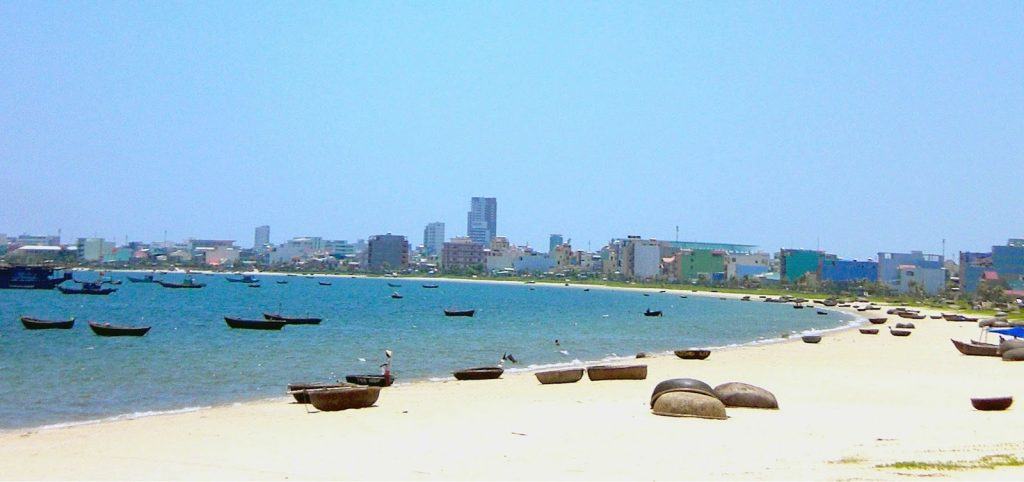
South Central Coast (Vietnamese: Nam TrungBộ) is one of the regions of Vietnam that consists of the independent municipality of ĐàNẵng and seven other provinces. The two southern provinces NinhThuận and BìnhThuận are sometimes seen as part of the Southeast region.
One of the main gateways to neighboring Central Highlands, the region made up of mountain ranges that favors tourism in areas such as around Phan Thiet, Nha Trang, and Da Nang.
Other tourist attractions in this region are the Cham cultural heritage, architecture, performances, and museums.
a. My Khe Beach
Many stunning beaches in South Central Coast are famous in international travel magazines, such as the gorgeous My Khe beach listed as one of the world’s six most attractive beaches and once listed in Forbes Magazine as one of the ‘World’s Most Luxurious Beaches.’
The 20-mile white sandy stretch of My Khe Beach was named by the American troops during the Vietnam War. Known locally as Non Nuoc, the beach offers excellent surfing and a host of numerous luxurious resorts and hotels.
My Khe Beach is perfectly located at near World Heritage sites – the ancient port of Hoi An, the mysterious Phing Nga Caves, the home place of the Champa population and the revered Imperial City of Hue are all easily accessible.
b. Po Nagar Cham Towers
Commonly known as Thap Ba, the Po Nagar Cham Towers are a complex of temples on a mountain called Cu Lao, in downtown Nha Trang, next to Cai River.
Built between the seventh and 12th centuries AD., the Po Nagar Cham Towers complex is one of the many relics of the Champa Kingdom, the most significant power in South Vietnam from 200 – 1720 AD.
The Cham civilization originated in Ancient India and was influential in Southeast Asia, especially in Vietnam and Cambodia. The Cham ruled Vietnam for 10 centuries, influencing Vietnam’s architecture and art style.
There are four towers remaining at the complex from an original eight, each of which displays different styles dedicated to various gods.
Late afternoon is a good time to visit these wonderful remnants of ancient history.
c. Tuong Phat nhap Niet Ban
The largest reclining Buddha statue of Vietnam and the most famous tourist site in Phan Thiet is a sacred Buddhist pagoda called Linh Son Truong. The pagoda is on top of Ta Cu Mountain where Buddhist pilgrims and tourists come to visit and worship daily. Here you can see and admire a series of statues including the world’s second largest reclining Buddha statue — a white stone statue of Thich Ca Nhap Niet Ban (Buddha entering Nirvana) that is 49 meters long and 18 meters high.
This concrete statue, which was constructed in 1962 lies just below the summit of the almost-700-meter-high mountain. According to the monks at the pagoda, the statue is made up of thousands of tons of cement which was transported to the location by workers through a two-kilometer rugged path and took four or five years to complete.
Linh Son Truong Tho Tu Pagoda is surrounded by stone tables and chairs, where visitors can rest to drink tea, talk with the monks and enjoy the view.
Getting up the mountain is as exciting as the sight of the statue. You can either take a two to three-hout hike through the forest and get a chance to see birds, monkeys, and wild flowers along the trail or take the scenic 1.64-kilometer cable car system where you can enjoy the scenic panorama of paddy fields, green hills, rivers and the sea in the far distance.
6. CENTRAL HIGHLANDS (Tây Nguyên)
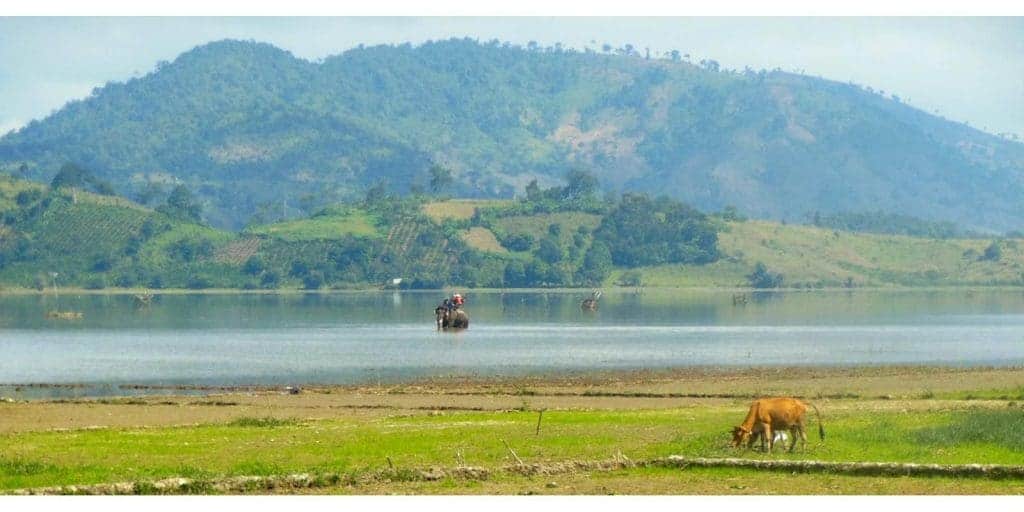
Central Highland (Tay Nguyen) is a plateau located in the central part of Vietnam, a region with five provinces. For those who want to get off the usual tourist trail, the highlands are a great destination. The Central Highlands boasts of beautiful natural wonders such as untouched forests, waterfalls and spectacular scenery.
Central Highland is also home to a large population of ethnic minorities such as Ede, Bana, Giarai,etc. that showcase a lot of impressive traditions and cultures.
Due to the Highland’s elevated altitude, the weather is cooler than on Vietnam’s coast. Even in the hot season, mornings and evenings are chilly and really cold late at night.The temperatures during the cool season (November to January) runs between 12 to 15 degrees Celsius.
a. Yok Don National Park
Yok Don National Park, is largest and most biodiverse protected area, encompassing 115,000 hectares of forest. The park runs all the way up to the border with Cambodia, with the Srepok River flowing through it.
There are over sixty species of animals, including tigers, leopards and bears, and more than 450 types of birds, that reside deep in the interior of the forest.
If you start off early in the morning you might see tribal folks carrying raffia backpacks on their way to work in the fields.
The best time to trekthrough Yok Don National Park is during the dry season from October to April. There are a surprising number of activities that you can enjoy at the park such as boat trips, catch and release “fishing and hammock time” where you can enjoy a beer while watching the locals on the river, or swimming with the elephants.
b. Lak Lake
One of the most famous tourist destinations in Central highlands is its largest natural freshwater, the Lak Lake. It is a breathtaking beauty: stunning rural scenery, dotted with minority villages and dugout canoes.
Lak Lake used to be the location of one of the palaces of Bao Dai, the last emperor of Vietnam, with the huge lake serving as a resort catered to wealthy Vietnamese folks. As part of your day tour, you can visit Bao Dai’s palace and experience an awesome panoramic view of the valley and the lace from the balcony on the second floor.
Other parts of the tour include checking out the lake’s lovely lotuses, the dug-out canoes of the M’nong tribe, visiting Jun Village.
7. SOUTHEAST VIETNAM (Đông Nam Bộ)
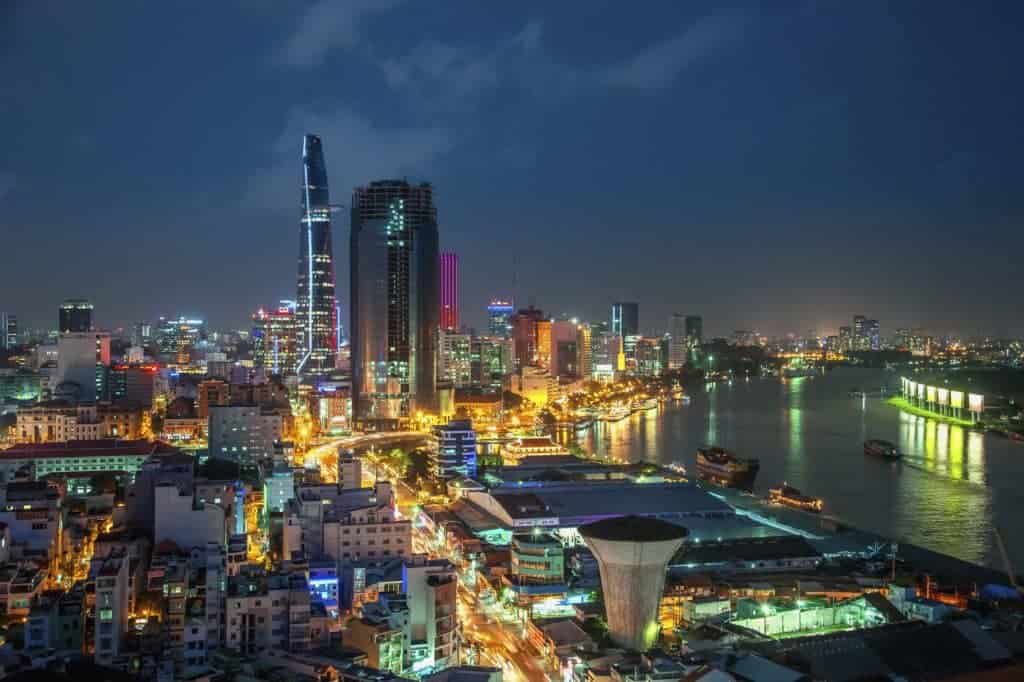
Dong Nam Bo region is composed of just one municipality, Ho Chi Minh City, or Saigon, and five provinces, ĐồngNai, BìnhDương, BàRịa–VũngTàu Province, BìnhPhước and TâyNinh. In the north, theregion borders Cambodia.
Southeast Vietnam is considered the most economically developed region in the country. This region has been the country’s concentration of foreign investments due to the massive growth driven by the huge energy and manufacturing sectors. The region’sHo Chi Minh City, as the country’s commercial hub, contributes to a gigantic share of the national economy with its wide set of industries: tourism, mining, construction, seafood processing, electronic, agriculture, and more. Southeast Vietnam is a picture of flat terrains, low hills, glistening rivers.
This region is home to the largest airport in the whole of Vietnam, the Ton Son Nhat International Airport.
Places to visit:
a. Ho Chi Minh City
With a population of over 7 million, it is the largest city in the entire Vietnan. It is commonly known as Saigon, and historically famous for its crucial role in the Vietnam War.
Ho Chi Minh City is strikingly beautiful for its prominent French colonial landmarks, like the Notre-Dame Cathedral and the 19th Century Central Post Office. Famous historical attractions in this metropolitan include the Reunification Palace, the War Remnants Museum, City Hall, Museum of Vietnamese History, and Ho Chi Minh Museum.
Religious sites include the Central Mosque, the Notre-Dame Cathedral, ThienHau Pagoda, Quan Am Pagoda, and Phung Son Tu Pagoda.
Other tourist attractions in Ho Chi Minh include the Saigon Skydeck, Dam Sen Waterpark, shopping areas and amazing marketplaces.
b. Mekong River
For some major nature’ tripping and be rewarded with some of Vietnama’s fantastic views, visit the Mekong River—the 7th longest river in Asia and the 12th in the planet.
Enjoy a long stretch of diverse wildlife. Day tour, two-day tours, luxury cruise, you pick.
This river is a major trade route between western China and Southeast Asia. It is also recognized as the center for Vietnamese culture and major transportation channel for villagers residing in the Delta.
Enjoy vibrant and colorful floating markets that sell seafood, flowers, exotic fruits, and more.
c. Chu Chi Tunnels
Built by the Vietcong during the Vietnam War to stave off American soldiers, the Chu Chi tunnels are part of the huge network of tunnels. Go back in time and check out the headquarters (with maps still posted), military hardware, and more.
8. MEKONG RIVER DELTA or WESTERN REGION
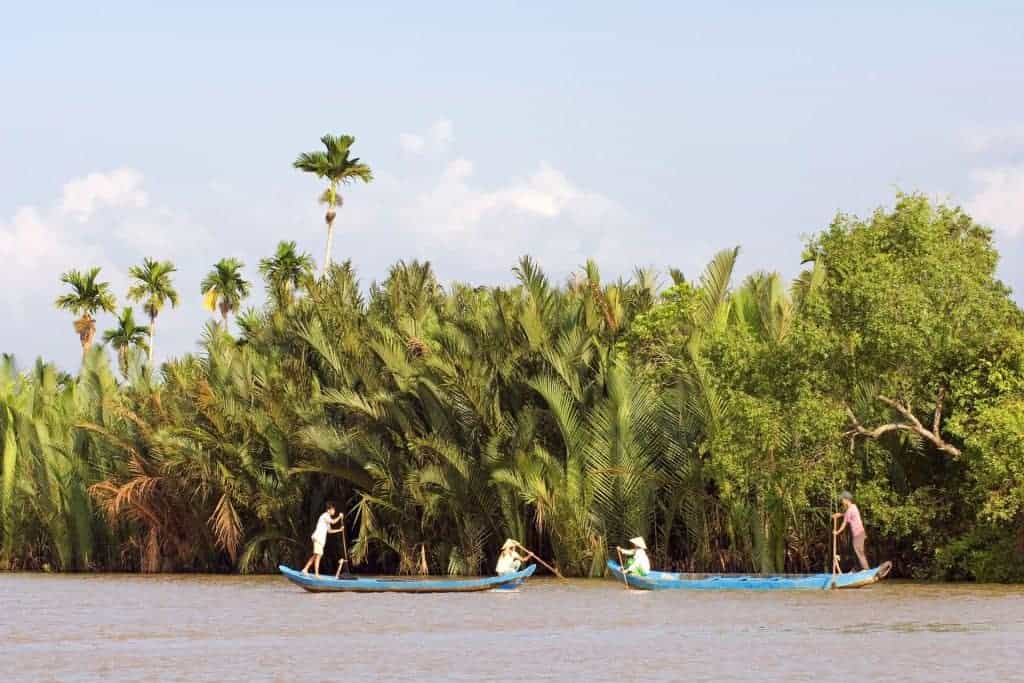
The Mekong Delta consists of a large section of southwestern Vietnam – about 39,000 kilometers. It is also known as a “biological treasure trove,” boasting of over a thousand animal species (as of 2007).
In Mekong Delta, you can enjoy bicycle tours, floating markets, river cruises, fish farms.
Helpful articles and blog posts on regions of Vietnam:
We only recommend writers and blogs that we read regularly and believe will deliver substantial value to our readers. The following is our top picks of articles we think are worth reading.
- “Vietnam’s Central Highlands by Motorbike” – by Follow Me East
- “Vietnam: 3 weeks from Ho Chi Minh to Hanoi” – by travelNation
- “My 1-month Vietnam Itinerary” – by That Backpacker
- “Northern Vietnam Motorcycle Adventure” – by Nomadasaurus
- “Vietnam Backpacking Guide” – by Indie Traveller
How Did We Do?
Is the article “Get to know the 8 beautiful regions of Vietnam” useful? If so, please share and like this post, as it helps other travelers find information. Many thanks! You can follow us on Twitter or Facebook for further updates!


